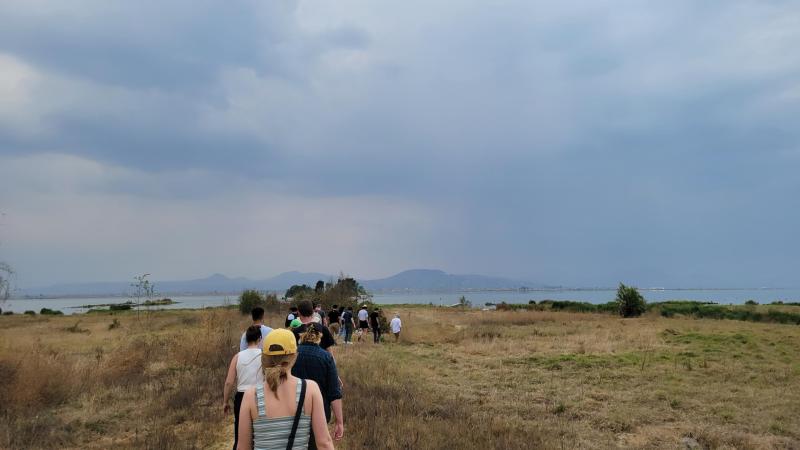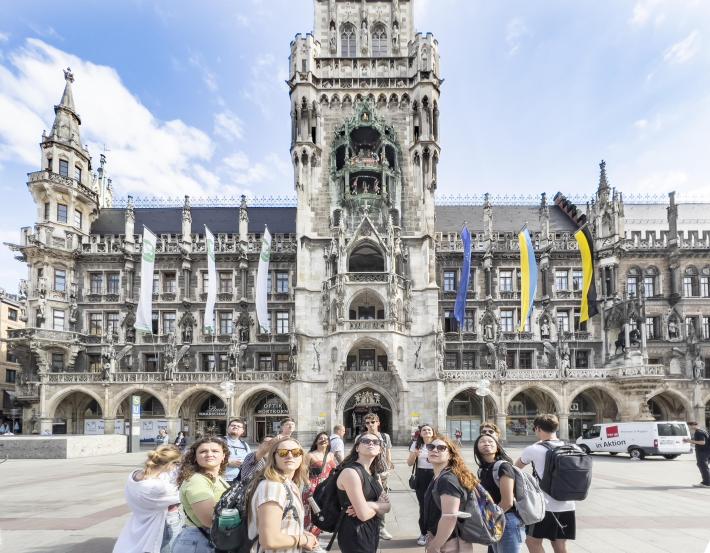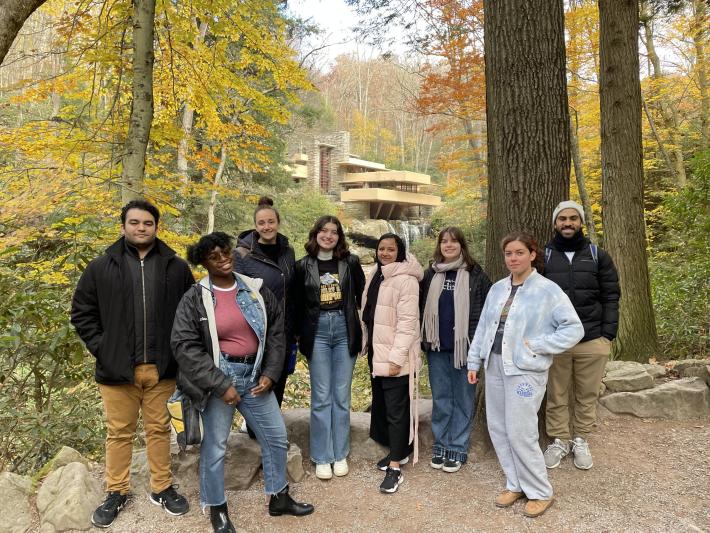Expanding the Horizon: Mexico City Study Abroad
Knowlton School students travel to Mexico over spring break to study the culture, landscape, and architecture of its capital city.

Expanding the Horizon: Mexico City Study Abroad
Following Highway 136D, a cohort of Knowlton School students pass beyond the metropolitan zone enclosing Mexico City’s urban density and enter a flat, barren landmass that stretches for miles. The group is bound for the Parque Ecológico Lago de Texcoco, whose reclaimed 35,000 acres of the ancient Lake Texcoco basin is on track to become the largest urban park in the world.
Inside the gates of Parque Texcoco, the students meet Iñaki Echeverria, the architect and land urbanist selected by the Mexican government to design the park. Standing before one of the last ancient lakes of the valley, Echeverria describes the vast ongoing ecological restoration project that incorporates nature, public spaces, and infrastructure.
From a mountain range in the distance, a thunderstorm approaches which will turn the sparse landscape in its path into salt marshes—articulating the challenge of storm-water management within an area known for its historical flooding.

“We had the opportunity to learn about the wetlands in the park and how to design around them,” said architecture graduate student Blythe Atzbach. “Details as small as concrete paver design and as large as multiple soccer fields were all parts of the design process we got to observe.”
The Parque Texcoco was one of many locations visited by Knowlton students in an intensive week-long trip over spring break to Mexico City, where they visited important archaeological sites, cultural landscapes, buildings, and design offices. Sites visited included Teotihuacan, Museo Casa Estudio Diego Rivera y Frida Kahlo, Museo Nacional de Antropología, and a chinampas boat tour in Lago de Xochimilco.

“Mexico City is very different in many ways from American cities—they exist at different densities and different scales,” said Dr. John Davis, assistant professor of landscape architecture and trip leader. “Mexico is unique as you encounter it at all different levels: it is sinking and rising. There are ramps and staircases built up over hundreds of years. The ground and the way people move through the city approaches both architecture and landscape architecture.”

For Caressa Givens, a first-year graduate landscape architecture student, a highlight of her study abroad experience was visiting Tatiana Bilbao Estudio after hearing the architect speak at Knowlton as part of the Autumn 2022 Baumer Lecture Series (Bilbao also led the 2022 Herbert Baumer Memorial Seminars). “On every floor of the studio, there were beautiful sample materials and experimental processes for design iteration. Their model shop was bright, clean, and filled with drawers just for collaging! Our group also had the pleasure of learning more about a monastery that Tatiana shared with us during her lecture this past fall,” said Givens.
Architecture undergraduate Alexa Jankowsky indicated Templo Mayor, the main temple of the Mexica people in their capital city of Tenochtitlan (Mexico City), stood out for her. “Being able to see the remnants of the city that are centuries old was really impactful and a great reference point for the rest of my explorations of the city,” said Jankowsky.

“The urban life of the city, especially being one with such a rich history spanning multiple civilizations, was very interesting to me,” said architecture graduate student Ben Moody on the prevalence of the visible past in Mexico City. “I am very interested in cities and architecture's role in them, and many of my studio projects involve the intersection of architecture and large-scale infrastructural projects.”
The itinerary enabled each student to conduct fieldwork at one of the visited sites in Mexico City and the surrounding landscape and develop drawings and research narratives from time spent at the location. Specifically, students were directed to select an urban condition, although not necessarily a building or a landscape, that intrigued them and then document the site using the conventions of architectural drawings.
Mexico City Drawings








“The requirement was that the graphic work not be just a plan or perspective drawing,” said Davis. “It should be analytical and convey the proportions, relationships, and configurations of all the elements. It should also be expressive and capture what the student felt or why she felt the space to be intriguing.” In early April, an exhibition of the students’ drawings was held in the center space of Knowlton Hall.
Moody chose for his drawing project the busy street intersection on Reforma Avenue, a major street that runs through the city. “While not necessarily a major location of interest architecturally or culturally, I felt this was a compelling site because here the city felt very alive with cars and pedestrians and noise, but it was also teeming with nature,” said Moody. “This surprised me about the city overall. Like New York or Tokyo, Mexico City is a modern metropolis, yet here there is a very unique plant life that fuses with the city.”

Reflecting on the trip, Jankowsky indicated the architecture was quite different than what she expected: “The building envelopes there are much looser than they are in the states and in many of the projects we study at Knowlton. It was exciting to see in Mexico City how the line between inside and outside is not as harsh. I think this changed my view of what characteristics a building envelope needs in order to be successful.”
Landscape architecture undergraduate Keagan Pauff concluded: “I think the atmosphere was the most surprising and enjoyable aspect of the city. The people were nice and the atmosphere was very relaxed and the sense of history was palpable. The city itself was also incredibly accessible which really heightened the trip.”





